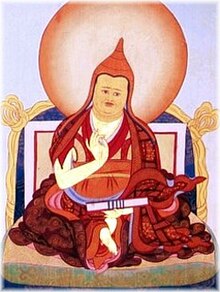Jamgon Ju Mipham Gyatso
| Mipham Gyamtso | |
|---|---|
 |
|
| Born | 1846 Kham, Tibet |
| Died | 1912 |
| Notable work |
Beacon of Certainty Commentary on Śāntarakṣita’s Ornament of the Middle Way Trilogy of Innate Mind Lion’s Roar: Exposition of Buddha-Nature |
| School | Nyingma |
|
Main interests
|
Buddhist philosophy, Madhyamaka, Dzogchen, Pramana |
|
Notable ideas
|
His two models of the two truths doctrine, Fourfold pramana (valid cognition), Unity of purity and equality. |
|
Influenced
|
|
| Jamgon Ju Mipham Gyatso | |||||||||
| Tibetan name | |||||||||
|---|---|---|---|---|---|---|---|---|---|
| Tibetan | བྱམས་མགོན་འཇུ་མི་ཕམ་རྣམ་རྒྱལ་རྒྱ་མཚོ་ | ||||||||
|
|||||||||
| Chinese name | |||||||||
| Traditional Chinese | 米龐仁波切 | ||||||||
| Simplified Chinese | 米庞仁波切 | ||||||||
|
|||||||||
| Transcriptions | |
|---|---|
| Wylie | 'jam mgon 'ju mi pham rnam rgyal rgya mtsho |
| THDL | Ju Mipam Namgyel Gyamtso |
| Lhasa IPA | [d̠ʑàmɡøn tɕù mìpʰam námcɛː(l) càmtsʰo] |
| Transcriptions | |
|---|---|
| Standard Mandarin | |
| Hanyu Pinyin | Mǐpáng Rénbōqiē |
Jamgön Ju Mipham, or Mipham Jamyang Namgyal Gyamtso (1846–1912) (also known as "Mipham the Great") was a very influential philosopher and polymath of the Nyingma school of Tibetan Buddhism. He wrote over 32 volumes topics such as painting, poetics, sculpture, alchemy, medicine, logic, philosophy and tantra. Mipham's works are still central to the scholastic curriculum in Nyingma monasteries today. Mipham is also considered one of the leading figures in the Ri-me (non-sectarian) movement in Tibet.
"Ju" ("holding") was Mipham's family name as his paternal clan is said to have originated as clear light deities who came to the human world holding a rope. "Jamgön" (Skt. Maitreya) indicate that he was considered to be an emanation of the bodhisattva Maitreya. his maternal uncle, Minister-Lama Drupchok Pema Tarjay, named him Mipham Gyamtso ("Invincible Ocean" or "Unconquerable Ocean"). In Tibetan literature, the word "mi-pham" is the standard translation of the Sanskrit "ajita", meaning "unconquered", which is a common epithet of the celestial bodhisattva Maitreya.
Mipham the Great was born to an aristocratic family in 1846 in the Derge Principality of Kham or Eastern Tibet. He was recognized as an exceptional child from a young age, memorizing texts as early as age six. By the age of ten he had already composed many texts. At twelve, he entered the monastery as an ordinary monk of the Ogmin Urgyen Mindrolling lineage at a branch monastery of the great Nyingma seat Shechen.
When he was fifteen or sixteen, after studying the very difficult Mindrolling system of chanting for only a few days and praying to Manjushri, he is said to have completely mastered it. In an 18-month retreat he accomplished the form of Manjushri known as 'Lion of Philosophers' (Tibetan: smra ba'i seng ge), using a liturgy composed by the fifteenth Karmapa, Khakhyab Dorje. He made many medicinal pills blessed with Manjushri's mantra, and many miraculous signs were said to have been manifest. After this, it was said that he could accomplish any sutra or tantra without any effort, and no text was unknown to him. He went to many lamas to obtain the necessary lungs (oral transmissions), but he needed no study or teachings for any texts.
...
Wikipedia
